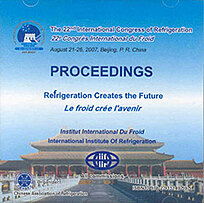
IIR document
The boundary layer velocity measurements in a high-amplitude standing wave thermoacoustic stack.
Author(s) : MAO X. A., JAWORSKI A. J., SHI L.
Summary
In this study, the hot-wire anemometry is used to investigate the high-amplitude velocity oscillations inside a parallel-plate stack of a standing-wave thermoacoustic resonator. The ratio of the peak acoustic pressure amplitude to the ambient pressure, defined as the drive ratio (Dr), ranges from 0.3 to 6.0%. The applicability of hot-wire anemometry technique for a time-resolved velocity measurement is studied, typically at a low Dr of 0.5%, in which the condition the flow is very likely to remain laminar. At higher drive ratios, turbulent bursts start to be generated and the velocity waveform becomes strongly fluctuating. By comparing the velocity fluctuations measured in different regions of the viscous boundary layer, the transition behaviour is analyzed. The importance of this study lies in developing reliable measurement techniques for use in thermoacoustic systems and a critical analysis of the capabilities of the hot-wire anemometry in particular.
Available documents
Format PDF
Pages: ICR07-A1-281
Available
Public price
20 €
Member price*
Free
* Best rate depending on membership category (see the detailed benefits of individual and corporate memberships).
Details
- Original title: The boundary layer velocity measurements in a high-amplitude standing wave thermoacoustic stack.
- Record ID : 2007-2627
- Languages: English
- Source: ICR 2007. Refrigeration Creates the Future. Proceedings of the 22nd IIR International Congress of Refrigeration.
- Publication date: 2007/08/21
Links
See other articles from the proceedings (839)
See the conference proceedings
-
Measurement of thermal boundary layer in a chan...
- Author(s) : MAO X. A., JAWORSKI A. J.
- Date : 2007/08/21
- Languages : English
- Source: ICR 2007. Refrigeration Creates the Future. Proceedings of the 22nd IIR International Congress of Refrigeration.
- Formats : PDF
View record
-
Characterization of inexpensive stack materials...
- Author(s) : YAHYA S. G., MAO X., JAWORSKI A. J.
- Date : 2015/08/16
- Languages : English
- Source: Proceedings of the 24th IIR International Congress of Refrigeration: Yokohama, Japan, August 16-22, 2015.
- Formats : PDF
View record
-
Experimental study on a simple Ranque-Hilsch vo...
- Author(s) : GAO C., ZEEGERS J. C. H., WAELE A. T. A. M. de
- Date : 2003/04/22
- Languages : English
- Source: Cryogenics and refrigeration. Proceedings of ICCR 2003.
View record
-
Two-dimensional analysis of the tube section of...
- Author(s) : ZAKER A., SAIDI M. H., HANNANI S. K., et al.
- Date : 2007/08/21
- Languages : English
- Source: ICR 2007. Refrigeration Creates the Future. Proceedings of the 22nd IIR International Congress of Refrigeration.
- Formats : PDF
View record
-
Transverse temperature distribution inside the ...
- Author(s) : WU F., KAN X. X., YU S. C., et al.
- Date : 2008/04/05
- Languages : English
- Source: Cryogenics and refrigeration. Proceedings of ICCR'2008.
View record
